Hey Steemit!
Here is my homework post for Professor @nane15. It was a great lesson, and I hope you will enjoy reading my post.
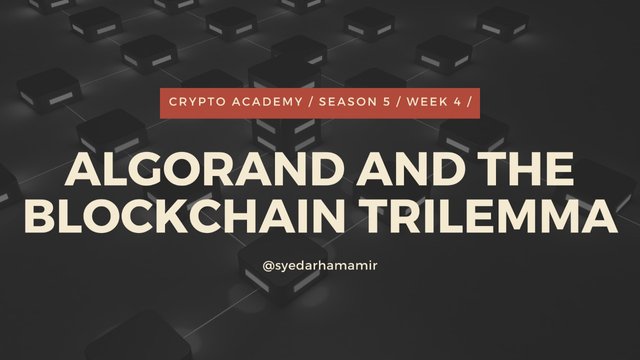


Algorand Blockchain
Algorant is a contemporary blockchain, also known as a third-generation blockchain, that was established, in my opinion, by learning from the mistakes and issues that previous blockchains had.
The primary goal of Algorand is to solve this Blockchain Trilemma conclusively, and the second goal, which can be seen very clearly in Algorand, is to match or surpass Ethereum ln respect of everything related to dApps.
Algorant is a massively extensible blockchain network that can handle thousands of transactions per second. This blockchain aims to be a "permissionless" network, meaning that anybody may use it without requiring expensive equipment or big sums of money.
As I said at the outset, Algorand has learnt from the faults of previous blockchains, and as a result, it has upgraded the PoS consensus algorithm and upgraded it to PPoS.
Algorant is now winning the war even against blockchain trilemma owing to the PPoS decision technology, which provides decentralisation, scalability, and security all at the same time.
Algorand, in my view, is the blockchain's "child" of the future.


PPoS
Algorand employs the PPoS unanimity system, which aims to address some of the PoS consensus method's flaws. PPoS operates in rounds, with the developers of new blocks being picked via a lottery-style procedure, and also a committee in responsibility of checking and confirming such block.
The rounds are selected using a process known as Verifiable Random Function (VRF), that are functions in charge of selecting those who will be in charge of creating, verifying, and validating new blocks, all while taking into consideration an amount of tokens, in this scenario, the sum of Something which each user or node owns.
To recapitulate, the PPoS consensus mechanism operates in each round utilising the following two steps:
The people in charge of constructing the new block are elected.
As previously stated, this pick is made by a lottery utilising a method known as Verifiable Random Function (VRF). Because each token is comparable to a lottery ticket, the more Anything a node has, more the possibilities it has of being picked. The individual in responsible of constructing the new blocks is so identified.
The people in charge of evaluating and approving the newly constituted block are elected.
The Verifiable Random Function (VRF) are utilised in the same manner as in the previous phase to choose a committee via a lottery that will be in charge of evaluating and approving the newly generated block.


Advantages
This is a massively scalable and fast common understanding system.
Participation does not necessitate the purchase of expensive or specialised equipment.
It does not necessitate the freezing of money. They may be used at any moment by the user.
It is available to the majority of people because participation requires only a small investment.
It makes no difference if the node doesn't even have a lot of money; it always has a freedom to make a new block.
Disadvantages
The absence of retribution or repercussions for those who seek to cheat is the fundamental downside of the PPoS consensus. Despite the fact that there are rules to follow in these situations, and it is extremely hard for them to succeed, there is no consequence for those who attempt, resulting in fresh attackers surfacing every day because they have nothing more to lose.
Another disadvantage is that this technology is still in its infancy. Despite the fact that it is a highly promising technology, it still has a long way to go in terms of demonstrating its long-term viability.
Finally, a minor drawback is that the person with the most money has always had a benefit, because even if a randomized method is utilised, the person with the most tokens is now more likely to pick, which is ultimately what matters. The same thing applies in PoW, where the best team has an advantage, and in PoS, when those with the most blocked tokens are picked.

4. Do you think Algorand really solved the blockchain trilemma? Explain your answer.

Algorant has enhanced and fixed many of the problems and shortcomings that other blockchains have, and as stated at the start of this essay, Algorant's major goal was to solve the Blockchain Trilemma.
First and foremost, Algorant satisfies the Security requirement because the PPoS consensus relies on random systems, which makes it very difficult to carry out a 51 percent attack or other attacks of this nature because there are never any nodes or fixed users in charge of a process of constructing and verifying the blocks, so an intruder would have no fixed target.
In terms of decentralisation, Algorand is undeniably a completely decentralised blockchain. Because various nodes are constantly picked, there is no way for the power to be concentrated in a perfectly fixed location due to the random method. It is much less important to have any form of creature which has strength or benefit over other nodes.
Finally, Algorand is among the most versatile blockchains available today, capable of performing thousands of actions per second in the same way that centralised systems do.
In my perspective, Algorand is now overcoming the Blockchain Trilemma, but it is still a very new network that must show that its results can be sustained over time.


PoW's lack of scalability is addressed with Algorant. The amount of operations that PoW blockchains can handle is limited, and at times of strong demand, they get saturated, resulting in expensive commissions.
The PoW consensus, on the other hand, necessitates a major investment in specialized tools to take part, not to notice that all these expensive equipment consumes a large amount of electricity, resulting in an additional cost for the participants, as well as a strong effect and aggressiveness the with environment.
PPoS overcomes all of the issues that PoW consensus has. Because they do not involve doing mathematical operations to produce and verify new blocks, PPoS consensus systems can handle practically any quantity for operations. Instead, they use a random mechanism that works relatively quickly.
PPoS also unquestionably reduces the amount of money necessary to join the network. There is no need for costly equipment; all that is necessary would be that the user has a sufficient number of tokens.
PPoS has a low power consumption and hence does not hurt the environment since it does not need costly equipment.
These are the factors that make PPoS a superior consensus mechanism than PoW in my view.


PPoS is a protocol built on top of PoS with the goal of addressing some of PoS's flaws.
When it comes to scalability, PPoS is preferable, but that does not imply it flexibility in PoS is poor. Thousands of operations may be processed each second using PoS. If there is a difference in scalability between these two agreement technologies, it is not really evident or tactile to consumers since they are both highly quick and scalable.
In terms of security, I believe PPoS has an edge. The creation of the new block occurs in the PoS consensus by applying random processes, and in the same way that this one is done by selecting those with largest number of units, it is possible that holders of massive wealth always are chosen and, at some point, can collaborate with one another to bring out some type of 51 percent or similar attack.
Although users with the most tokens seem to be more likely to pick by the random method, the reality that they will be always same chosen people is abolished in PPoS, since the system gives a benefit to those with more tokens who could also be chosen. Users with less tokens are prioritised, which is not the case with PoS, where the wealthiest users are always picked.
PPOs' decentralisation outperforms PoS because different nodes are always chosen, regardless of their wealth, despite the fact that wealth delivers more probable outcomes, as mentioned previously. This removes the possibility of a node and group of nodes monopolising power by obtaining the most number of tokens, as is the case with PoS.
These are some of the factors why I believe PPoS is a superior consensus mechanism over PoS.


The first thing would be to go to algoexplorer page. We'll see the platform in the picture below, and we'll be able to view all of the actions which are being processed just on blockchain, together with their related data, in the red boxes.
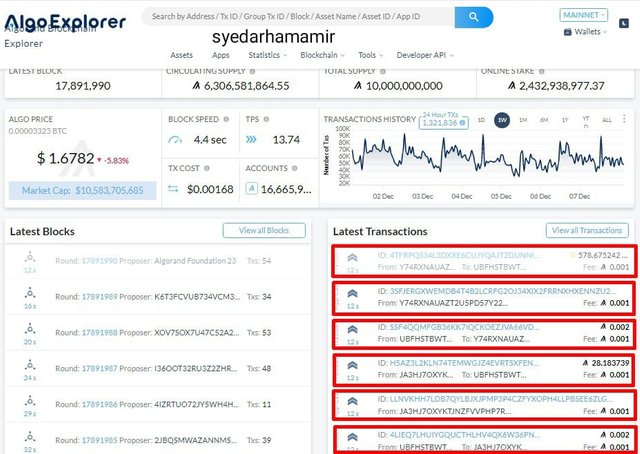
We may view much more data if we tap just on id of any transaction.
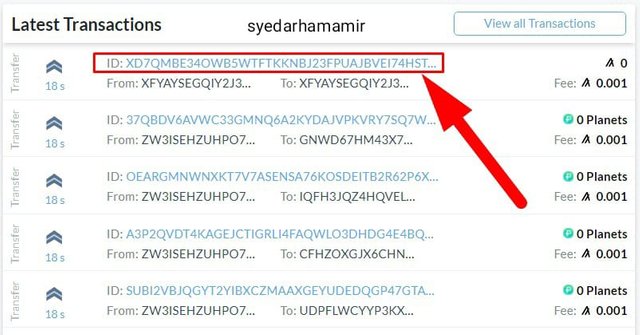.jpeg)
We can now view additional details of the transaction, including the time and date of a transaction, the kind of transfer of funds, the block, and the value, among other things.
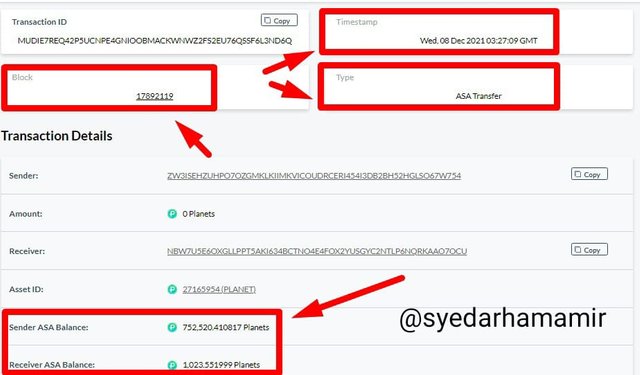.jpeg)

8. Carry out an analysis of the price of ALGO from the beginning of the year to the present. Via graphics

Carry out an analysis of the price of ALGO from the beginning of the year to the present. Via graphics (screenshots required.)
The following screenshot displays the price movement of ALGO throughout the year. You can notice that the price went bullish at the beginning of the year. After that, from February till the start of September, the price went bearish. Though there were some peaks made between the overall price movement was bearish. Then, in September, A bullish peak was made, and after the mid of September, the price started to go bearish. Since the mid of September, the price has been going bearish, though there were fluctuations in between.
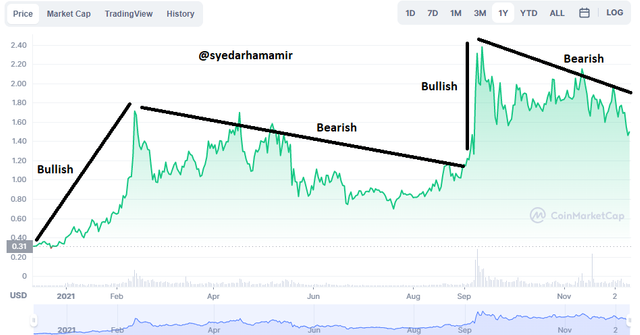


It has the advantage of having learnt from the flaws and mistakes that blockchain has shown before it, and of knowing how to utilise that knowledge to better and overcome the majority of the shortcomings that the PoW and PoS agreements have provided.
This form of blockchain appeals to me since it allows you to join without any need for costly equipment or significant numbers of money, and it is also highly quick and has cheap costs when used as a user.
Thanks to Professor @nane15 for sharing this amazing lesson with us.
@steemcurator02
Downvoting a post can decrease pending rewards and make it less visible. Common reasons:
Submit
@steemcurator02
Downvoting a post can decrease pending rewards and make it less visible. Common reasons:
Submit